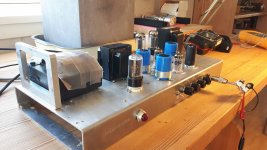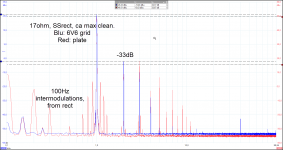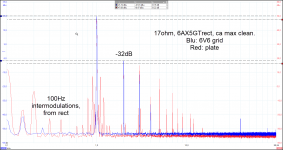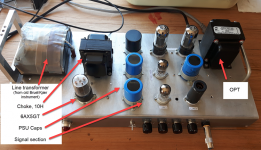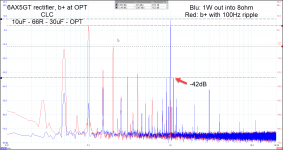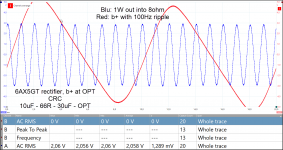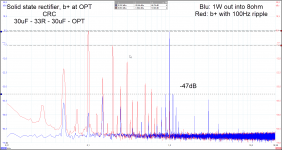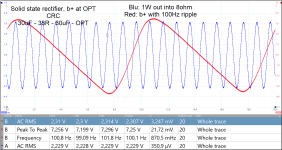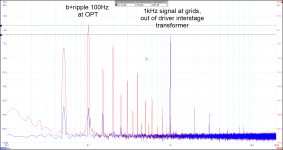This is an instrument amp, but the topic I think is relevant here in 'tube section' as well...?
To be clear, this amp sound absolutely amazing. I actually believe it has something to do with the NOS late '60s carbon comps - but lets not go there...sorry.
The point here is I am a little surprised at the amount of rectifier (100Hz+) intermodulations. Look at the 1kHz test signal and the harmonics around it, they are 100Hz apart. The first +-100Hz are only -40dB down.
This is at max clean power just below clipping. With 6AX5GT rectifier this is ca 12watts and with solid state it is ca 18watts.
I think I have the layout and routing ok. The power supply is at one end, the first cap is really close to the rectifiers. The b+ wire (red) is routed close as possible to the GND copper bus. The loops should be farely small and tight.
I have seen this when the magnetics (power supply) is close to the OPT or IT, but here I was expecting a little better.
Any comments?
Is this just normal?
To be clear, this amp sound absolutely amazing. I actually believe it has something to do with the NOS late '60s carbon comps - but lets not go there...sorry.
The point here is I am a little surprised at the amount of rectifier (100Hz+) intermodulations. Look at the 1kHz test signal and the harmonics around it, they are 100Hz apart. The first +-100Hz are only -40dB down.
This is at max clean power just below clipping. With 6AX5GT rectifier this is ca 12watts and with solid state it is ca 18watts.
I think I have the layout and routing ok. The power supply is at one end, the first cap is really close to the rectifiers. The b+ wire (red) is routed close as possible to the GND copper bus. The loops should be farely small and tight.
I have seen this when the magnetics (power supply) is close to the OPT or IT, but here I was expecting a little better.
Any comments?
Is this just normal?
Attachments
Can you provide the schematics for the PSU?
6AX5 is pretty wimpy, so using it for the 6V6 (?) PP amp and with big (?) caps in the PSU won't make for the clean output.
6AX5 is pretty wimpy, so using it for the 6V6 (?) PP amp and with big (?) caps in the PSU won't make for the clean output.
It makes a wonderful output. Clean to 12watts in 16ohms and just over 15watts into 8ohms. I am very happy with that rectifier. I can also use 5Y3.
But this thread regards the rectifier intermodulation. Not rectifier types please.
Will try and post schem. But I rather dont think that is critical for the subject.
But this thread regards the rectifier intermodulation. Not rectifier types please.
Will try and post schem. But I rather dont think that is critical for the subject.
5Y3 is rated at 125mA. 6AX5 is rated at about half that current.
This is barely enough to feed the 6V6 PP even with the correct PSU design, and if you're using large capacitor for the filter input (which seems to be the case), the rectifier will sag tremendously at the twice the mains frequency, trying to charge that capacitor.
This is barely enough to feed the 6V6 PP even with the correct PSU design, and if you're using large capacitor for the filter input (which seems to be the case), the rectifier will sag tremendously at the twice the mains frequency, trying to charge that capacitor.
So the reason is the high ripple at the OPT. Guitar amps of mine have minmal filtering on the b+.
solid state is 30uF - 33R - 30uF - OPT.
Tube is 10uF - 66R - 30uF - OPT.
The slightly higher ripple on the tube shows in the fft, higher intermodulated 100Hz.
This does not worry me, the amp is silent at the 99dB/W speaker. Now that I know what is going on I can deliver it...
solid state is 30uF - 33R - 30uF - OPT.
Tube is 10uF - 66R - 30uF - OPT.
The slightly higher ripple on the tube shows in the fft, higher intermodulated 100Hz.
This does not worry me, the amp is silent at the 99dB/W speaker. Now that I know what is going on I can deliver it...
Attachments
5Y3 is rated at 125mA. 6AX5 is rated at about half that current.
This is barely enough to feed the 6V6 PP even with the correct PSU design, and if you're using large capacitor for the filter input (which seems to be the case), the rectifier will sag tremendously at the twice the mains frequency, trying to charge that capacitor.
You are mistaking the 6AX5GT for a 6X5GT?
Hi, do you use elevated heaters? I remember I've read time ago someone solving this issue by elevating the heaters + placing snubbers on the diodes.
May I ask you to share the schematic of that amp? Nice to see you use low filtering on the amp, I've played very good sounding amps with low filtering.
May I ask you to share the schematic of that amp? Nice to see you use low filtering on the amp, I've played very good sounding amps with low filtering.
No, it is after the SS/tube rect first cap, so it's relatively DC.
But problem/mystery solved, see post number 5, the fifth post. I think it is to be expected when the plates get a 'signal' at 100Hz at that magnitude. The plates are electrodes after all, just not as effective as the grid or cathode. One hopes they get cancelled via the PP topology, but here nothing is that well matched.
The signal at the grids is 7dB lower than the 100Hz at the OPT. The output has less than 1% of the 100Hz into the 1kHz signal, so that is not bad actually.
But problem/mystery solved, see post number 5, the fifth post. I think it is to be expected when the plates get a 'signal' at 100Hz at that magnitude. The plates are electrodes after all, just not as effective as the grid or cathode. One hopes they get cancelled via the PP topology, but here nothing is that well matched.
The signal at the grids is 7dB lower than the 100Hz at the OPT. The output has less than 1% of the 100Hz into the 1kHz signal, so that is not bad actually.
Attachments
Hi, do you use elevated heaters? I remember I've read time ago someone solving this issue by elevating the heaters + placing snubbers on the diodes.
May I ask you to share the schematic of that amp? Nice to see you use low filtering on the amp, I've played very good sounding amps with low filtering.
Yes. elevated as always. Thnx for tip anyhow, thats a good one.
I will try to draw up the schem tonite. Time...
If it is "near clipping" it *will* intermodulate, no matter what small-signal cancellations (push-pull, NFB) you apply. This limited the nice-number ratings on SWTP's Tigers, dead-clean solid-state amps with marginally sufficient power caps (looked big at the time).
Not having that IM is reported to make the amp sound "dull, dead". Some German students put a super-clean supply in a 5F6A. Anybody remember that paper?
EDIT-- Ah.... indirect reference:
Class AB Power Supply Ripple
"Touch sensitivity - zero. Crisp dynamic overtones - zero. ...the WILDCAT became more like a kitty cat. The new power supply ....had suppressed the heart and soul of the amplifier!"
http://www.emsp.tu-berlin.de/fileadmin/fg232/Lehre/MixedSignal/Dateien/Wildcat/05_LowNoise_NTl.pdf
Also: Guitar amp power-supply question
Not having that IM is reported to make the amp sound "dull, dead". Some German students put a super-clean supply in a 5F6A. Anybody remember that paper?
EDIT-- Ah.... indirect reference:
Class AB Power Supply Ripple
"Touch sensitivity - zero. Crisp dynamic overtones - zero. ...the WILDCAT became more like a kitty cat. The new power supply ....had suppressed the heart and soul of the amplifier!"
http://www.emsp.tu-berlin.de/fileadmin/fg232/Lehre/MixedSignal/Dateien/Wildcat/05_LowNoise_NTl.pdf
Also: Guitar amp power-supply question
Last edited:
I have a Lil'Tiger. A SS preamp before it, into two Celestion speakers, the guy with the Fender Twin was not happy the Tiger had a better Marshall sound. Kept up with a loud drummer in the basement, forget clean though.
Not to sure about the resemblance to a AC30 above.
Not to sure about the resemblance to a AC30 above.
If it is "near clipping" it *will* intermodulate, no matter what small-signal cancellations (push-pull, NFB) you apply. This limited the nice-number ratings on SWTP's Tigers, dead-clean solid-state amps with marginally sufficient power caps (looked big at the time).
Not having that IM is reported to make the amp sound "dull, dead". Some German students put a super-clean supply in a 5F6A. Anybody remember that paper?
EDIT-- Ah.... indirect reference:
Class AB Power Supply Ripple
"Touch sensitivity - zero. Crisp dynamic overtones - zero. ...the WILDCAT became more like a kitty cat. The new power supply ....had suppressed the heart and soul of the amplifier!"
http://www.emsp.tu-berlin.de/fileadmin/fg232/Lehre/MixedSignal/Dateien/Wildcat/05_LowNoise_NTl.pdf
Also: Guitar amp power-supply question
Good point. I had read that paper but forgot.
I really find instrument amps interesting b/c of the 'character' needed that is so opposite of the almost boring hifi creations.
I totally agree: on guitar amps the power supply "sounds" together with the circuit and it's interesting to hear how they react. I replicated Mesa's DynaWatt concept for screens that works quite well scaling it for different currents, but I usually have stiffer plates (I have higher gain preamps).
- Home
- Live Sound
- Instruments and Amps
- Surprising amounts of rectifier intermodulation
